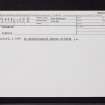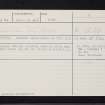Friarton
Logboat (Period Unassigned)
Site Name Friarton
Classification Logboat (Period Unassigned)
Alternative Name(s) River Tay; Perth; Friarton Brickworks
Canmore ID 28388
Site Number NO12SW 24
NGR NO 1175 2192
NGR Description NO c. 1175 2192
Datum OSGB36 - NGR
Permalink http://canmore.org.uk/site/28388
- Council Perth And Kinross
- Parish Perth
- Former Region Tayside
- Former District Perth And Kinross
- Former County Perthshire
NO12SW 24 c. 1175 2192
See also NO12SW 210.
(NO 1175 2192) Ancient Canoe found AD 1879 (NAT)
OS 25" map, (1932)
(Location cited as NO c. 118 223). A dug-out canoe, probably made of pine, was found many years ago in the Friarton brickfield.
TPSNS 1886.
In 1878 or 1879 Geikie recorded the remains of the logboat that had been found 'a number of years' before during clay-digging at the Friarton brickworks, a short distance S of the City of Perth. The exact location of the discovery was not noted but an annotation on the 1932 edition of the OS 1:2500 map places it about 90m WNW of the present harbour, and at an altitude of about 10m OD.
The boat had been considerably damaged before examination when the surviving fragment was found to measure 10' (3.1m) in length and 3' (0.9m) in depth between the highest surviving and the lowest points; the dugout cavity measured 6' (1.8m) long by 2' (0.6m) deep and was 1'6" (0.5m) broad at the bottom while the highest surviving part of the side of the boat was 3" (8mm) thick. The timber was identified as 'Scotch fir' and extensive charring was noted. It was locally remembered that on discovery the boat had measured at least 15' (4.6m) in length and Geikie suggests that it had formerly measured about 3'6" (1.1m) and 3' (0.9m) in beam externally and internally respectively.
On the basis of the best available evidence for the dimensions of this boat, it was a medium-sized craft worked from a whole log and with proportional values within the mid-ranges of those normally found. The displacement was about 2.7 cubic metres while the slenderness and beam/draught coefficients were of the order of 4.3 and 1.2 respectively. The McGrail morphology code and the form of the boat cannot be ascertained on the basis of the available account.
The boat was said to have been found 'resting on its bottom' on the upper surface of the peat and sand layers that underlie the deep brickearth deposit of what Geikie termed the 'second alluvial terrace of the Tay'. This peat was laid down on the surface of former estuarine sediments during the period of low sea levels that was followed by the period of marine transgression during which the brickearth was deposited; this transgression is dated regionally to between 8400/8100 bp and 6800/6500 bp but the reported location of the discovery at an altitude of about 6.6m OD suggests that the area was inundated at a relatively late stage, probably in the later centuries of the 8th millennium bp. Assuming the account of the logboat being found at the base of the clay layer to be correct, a date within the later 6th millennium bc and in the later part of the Boreal climatic phase may be attributed to it.
J Geikie 1880; Cullingford, Caseldine and Gotts 1980; R J C Mowat 1996; information from Dr M Armstrong and Dr DG Sutherland.
OS 1:2500 map, Perthshire, 2nd ed. (1932), sheet xcviii.9










